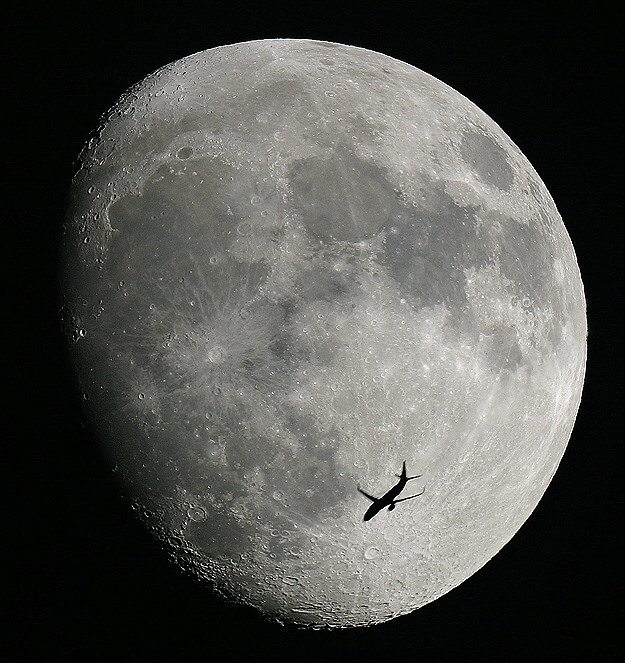
Our closest celestial neighbour has kept us company for at least four billion years and has entertained our imagination in a variety of ways.
It certainly has been involved in our maturation as a species with man's first step on a body beyond our planet during the latter part of the
twentienth century and will, inevitably, be our first stop prior to any sort of manned travel to a further celestial body such as Mars. The
moon has been a great source of education about our own planet's evolutionary history; it has entertained many inquisitive minds from earlier
cultures and generations about the universe in general and man's role in particular; it has enriched the minds of young children taking their
first look through a telescope and continues to impact our lives in ways we may or may not readily recognize including tidal forces and various
natural rhythms and cycles.
Note: The image below is the culmination of a multi-year effort in my attempts to capture a passing (passenger)
plane against the moon and which was finally realized in early July/2006. Although such a capture may seem relatively frequent, this is far
from being the case, for we need the passing plane to cover a specific area of the sky measuring 0.5 by 0.5 degrees (ie. one-quarter of a
square degree) and to do so with the moon sufficiently high above the horizon and with a favourable phase. Although the moon in the photo below
was only 25 degrees in altitude, relatively stable skies made for a favourable and successful capture. The nosetip of the airplane in the photo
below is above the well-known landmark crater of the southern lunar hemisphere Tycho whose (impact) rays are believed to extend well into the
lunar northern hemisphere. Furthermore, the plane is just to the east of the crash landing site for the SMART-1 mission a few weeks later and,
more specifically, Lacus Excellante.
Note: It is my understanding the passenger plane in the photo below is a Boeing
737-800X model with a wing span of 34.31 meters, a length
of 39.47 meters, a height of 12.55 meters and a wing area of 125.0 meters2. It requires a flightcrew of two and can seat between
162 and 189 passengers. If you have any further information, please let me know!
|
Body: Moon Mass: 0.0123 x Earth Mean Eq Diameter: 0.2719 x Earth Distance: 384,664 km Sidereal Rev: 27d 07h 43m 11s Age: 11d 06h 22m Phase: 87.0° Diameter: 31.30' Magnitude: -11.6 Rukl: N/A |
 |
Date: Jul 07, 2006 22:30:34 UT+3 Location: Athens, Greece Equipment: AP 160 f/7.5 StarFire EDF Losmandy G-11 GEM Canon EOS 300d Exposure(s): 1/125 sec ISO 100 RAW Image Format 3072x2048 Image Size Manual Mode Software: Canon FileViewer V1.3.2 Photoshop CS-II Processing: RAW to TIFF (16-bit) Conv Unsharp Masking Resampling JPG Compression |